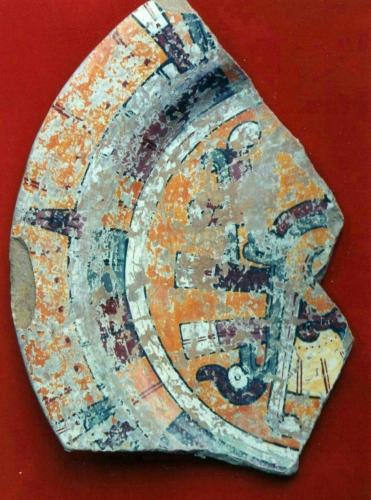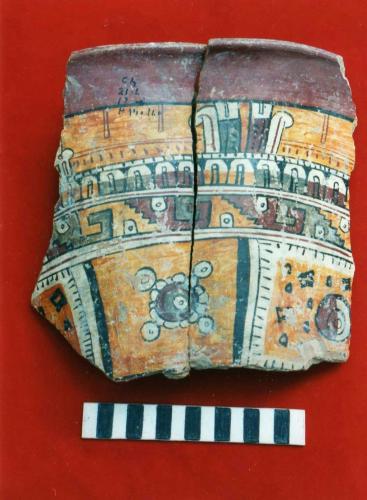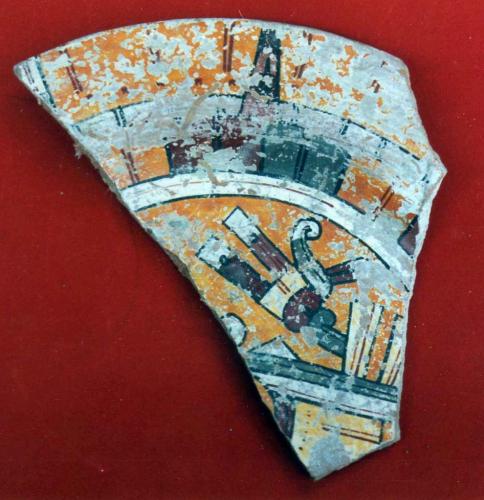Coapan Laca Polychrome
Coapan Laca is characterized by its lacquer-like finish over a white base coat, and especially by the elaborate use of multiple colors in intricate, "codex style" motifs. Noguera (1954:138) described this as the most beautiful ceramic of Cholula, and possibly of all of prehispanic Mexico.

Paste and Firing Effects
The paste is light brown to light reddish-brown in color, typical of Cholula decorated wares. The paste is fine to medium grain with few inclusions. Recent trace-element analysis of polícroma laca (Neff et al. 1994), identified a distinctive compositional "fingerprint" for the Puebla area, with sub-regional variation from Cholula, Huejotzingo, and Tlaxcala. Coapan Laca is well-fired to a moderate to hard hardness. Firing anomalies were rare in the small sample from UA-1.
Surface Treatment
The surface is covered with a thick white base coat, over which is applied an orange slip with additional painted decoration. One of the characteristics of the type is the generally poor bond between the undercoat and the exterior paint, such that it tends to flake off (Noguera 1954:139). For this reason many archaeological examples of Coapan Laca are nearly unrecognizable because of the degree of deterioration of the outer surface. The painted surface was well burnished, often to a high luster.

Coapan Laca plate showing eroded surface
Decoration
Coapan Laca has painted decoration in complex geometric and naturalistic designs, often including codex-style glyphic symbols. Colors include red, black, white, yellow, brown and gray, in addition to the orange of the slip.
The tremendous variety in decorative themes and the elaboration with which they are created makes it difficult to characterize the painted motifs found on Coapan Laca. Lind (1994) presents a detailed comparison of Coapan Laca ("Catalina Polychrome") and Pilitas Polychrome from the Mixteca Alta using complete or reconstructed vessels from excavated contexts and museum collections. Approximately 50 distinct design motifs were identified for the Cholula polychrome, with the most common being xicalcoliuhquis, feathers, bone awls and maguey thorns (probably representing auto-sacrifice), plumed serpents, sacrificial knives and xonecuillis. On average, about three different motifs occurred on each vessel. The high frequency of symbolism relating to ritual sacrifice suggests a ceremonial function for this type (Lind 1994).
Vessel Forms
Coapan Laca occurs in forms associated with serving wares, but because of the possible ritual uses for some of these forms it probably has a ceremonial significance as well. The most common vessel forms recovered at UA-1 included conical bowls, flared rim outleaned wall dishes, and superhemispherical bowls. Based on his larger sample, Lind (1994) includes tripod cajetes (bowls), goblets, and hemispherical bowls. About half of the Laca vessels had vessel supports, usually in the form of a conical ring, but also with tripod supports. Decorated tripod supports included zoomorphic representations and the modelled face of the "Old Man" god, Huehueteotl. Another significant type that occurs is a flared rim cylindrical censer, with decoration on the exterior while the interior is charred gray, probably from burning incense. This vessel form features two horizontal handles for carrying or suspending the vessel during use.

Coapan Laca tripod plate with jaguar support
Discussion
Coapan Laca Polychrome is the most famous of the Cholula polychrome ceramics because of its high quality and codex-style motifs. Due to its fame it is included among the "Major Decorated types" even though it made up less than 2% of the total UA-1 assemblage.
Noguera (1954:296) concluded that polícroma laca was diagnostic of the Early Postclassic period, inferring an evolutionary relationship linking it to Classic period "fresco ware" from Teotihuacan (Noguera 1954:142). Similarities between this type and polychrome from the Mixteca Alta were fundamental in postulating a "Mixteca-Puebla" stylistic horizon (Noguera 1954:142; Nicholson 1960, 1982; Lind 1994).
As discussed in Chapter II, the type described by Noguera (1954:138-142) as polícroma laca combined varieties of several polychrome types, although Coapan Laca is probably the prototype. While numerous vessels were illustrated, Noguera (1954:140) noted that one of the characteristics of laca is its individuality, with every piece uniquely different.
In previous ceramic analyses from the Universidad de las Américas, Mountjoy and Peterson (1973:31, Table 1) divided laca into three types: Cholula Polychrome A, Cholula Polychrome B, and Cholula Polychrome D. These types also included additional polychrome types defined by Noguera.
At UA-79, Feature F-10, Barrientos (1980) classified 3% (n=132) as "Coapa Polychrome." Lind (1994) renamed this type as "Catalina Polychrome" (a type combining Coapan Laca and Apolo Elegante), which occurred as up to 5% of the different UA-79 assemblages. Although these frequencies are still very low in terms of the total assemblage, they represent the highest concentration of the type from known excavated contexts. This suggests a Late Postclassic date for Coapan Laca, an interpretation in conflict with Noguera's original ceramic sequence. Additional evidence from an excavated burial from San Andrés Cholula (Suárez C. 1989, 1994) supports a Late Postclassic date for Coapan Laca Polychrome.
Coapan Laca was a minor type at UA-1, accounting for only .4% of the total assemblage (Table 1). The only primary depositional context at UA-1 in which this type was found was Well 1, where it appeared as only a single sherd (.3% of the Well 1 assemblage). Consequently, it is difficult to assess the significance of Coapan Laca on the basis of the UA-1 data. On the other hand, its relative absence is negative evidence useful for posing questions about the cultural significance of the type. Was this a type with a relatively brief popularity not represented at the UA-1 excavation? Or was its use restricted to more elite or ceremonial contexts in which the inhabitants of the UA-1 structures did not participate? Based on the limited evidence available, I suspect that both temporal and social factors inhibited the consumption of this type at UA-1.



